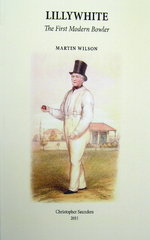Lillywhite
Archie Mac |Published: 2011
Pages: 104
Author: Wilson, Martin
Publisher: Christopher Saunders Publishing
Rating: 3 stars

William Lillywhite was the first great roundarm bowler. His dominance was such he earned the soubriquet of the “nonpareil” and was the most successful or second most successful bowler in England every year between 1828 and 1841.
Having played the game so long ago, it has not proven an easy task for his biographer, Martin Wilson, to procure too much information about the great bowler, apart from his involvement in cricket. It seems the scarcity of personal information was not from a lack of research from the author as demonstrated by an impressive bibliography and access to descendents of the Lillywhite clan.
The family tree of the Lillywhites’ has more skeletons in the closet than Vegas has Elvis impersonators. William Lillywhite’s mother was married twice with both husbands being named James Lillywhite, however it is believed William Lillywhite (the subject of the book) was fathered out of wedlock by a William Lillywhite, brother of one the James Lillywhites. Confused?
Keeping track of the family members becomes even harder as some of the Lillywhites are also First Class cricketers, with a nephew of our subject captaining England in the first of all Test matches. Other members of the clan went into the printing industry, producing the Lillywhite annual which was an early rival of Wisden. There was also a Fred Lillywhite who wrote the first tour book when a team of Englishman toured Canada and the United States.
While all of this was of curiosity value the part of the story which should have been of most interest, that of William Lillywhite the cricketer was sadly flat. Perhaps this was because of a lack of space but it would have been nice to read about Lillywhite and his rivalry with some of the great batsmen of his time such as George Parr and Fuller Pilch. Martin Wilson does provide some details of Lillywhite’s clashes with them however they are mainly of a statistical nature.
Although important he perhaps gives too much space to contemporary debate about whether roundarm bowling should replace underarm bowling. As the author points out some of the arguments for keeping the status quo “seem patently ridiculous.” It would seem he could have summarised the for and against arguments in a couple of pages rather than the 20 odd pages dedicated to the debate.
The book itself is well written and does not outstay its welcome at only 104 pages and apart from the minor criticism it is well worth a read. Full credit should also be given to Christopher Saunders who continues to publish quality cricket books that simply would not be produced by mainstream publishers.






Leave a comment